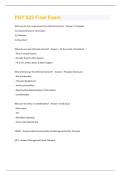Exam (elaborations)
PYC4805 - Child Development Exam Q&A
- Course
- Institution
- Book
This document contains all the exam questions and the answers that have been presented in the exam papers. Unisa has confirmed that 6 of these questions will be asked in the exams.
[Show more]













